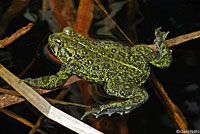
A Guide to California's
Reptiles and Amphibians
Sounds of
Boreal Toad - Anaxyrus boreas boreas
(Baird and Girard, 1852)(= Bufo boreas boreas)
| Most male Boreal Toads do not have a pronounced vocal sac, but they do make a call during breeding aggregations. Their call has been described as a high-pitched plinking
sound, like the peeping of a chick, repeated several times. Since it is not made to attract distant females, the call is not very loud when compared to the call of the sympatric Pacific Treefrog (or simiilar treefrog species.) The sound of a group of males calling has been compared to the sound of a distant
flock of geese. Some Boreal Toads have been found to make advertisement calls with a pronounced vocal sac. (See Zachary Long's findings below.) Calls are produced at night and during the day during the short breeding season. Males make their call primarily when they are in close contact with other males. Rather than being advertisement calls made to attract females, these calls are generally considered encounter or aggressive calls, or release calls, which serve to maintain territory and spacing between males. The calls may also serve other purposes - a lone male toad has been observed calling. It could also be possible that female toads are attracted to the sounds of male encounter calls, and can judge a male's condition by his call, similar to the function of an advertisement call. Unreceptive females may also produce a release call when grasped on the back by a male. Males and females sometimes make a release call when grabbed across the back by a human hand. (See video below.) On his website, and in his note in Herp Review (Zachary Long, Herpetological Review 41(3), 2010.), Zachary Long presents video and audio evidence of Boreal Toads making advertisement vocalizations in a wetland south of Whitecourt, Alberta, Canada. In his videos, you can clearly see that the toad has a vocal sack. When compared with the calls I have recorded in Washington State, you can easily hear the difference between them. You can listen to his recordings and watch his videos here. |
||
| The sounds below were recorded on a late sunny morning and early afternoon in early April from a small boat on a lake in Thurston County, Washington (courtesy of Jim Lynch, Fort Lewis Department of Fish and Wildlife.) The habitat is shown below on the right. The air temperature was approximately 60 degrees F. (15.6 C.) Male toads in a large group called continuously while floating and moving around on the water among the dry reeds of the marshy shoreline. Singing birds and distant traffic can be heard in the background. |
||
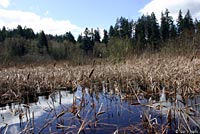 |
||
|
|
This is a 5 second recording of one male toad calling as part of a large group of continuously calling toads. Birds and distant toads can be heard in the background. | |
| This is a 9 second recording of the release call of a male toad, produced when the toad was picked up and grasped across the back. Birds and distant calling toads can be heard in the background. |
||
| This is a 35 second continuous recording of a group of male toads calling while floating on the water. | ||
| |
This is a 45 second continuous recording of a group of male toads calling while floating on the water. | |
| The sounds below were recorded on a late sunny morning and afternoon in early April from the shore of a small forest lake in Mason County, Washington (shown below right) (courtesy of Lisa Hallock, Natural Heritage Program, Department of Natural Resources.) The air temperature was approximately 55 - 60 degrees F. (12.8 - 15.6 C.) The toads were calling while floating on the water close to the shoreline. These toads were not calling continuously, but apparently called only when approached by another toad. Toads were observed swimming up to and climbing onto the back of another toad until calls were produced, water was splashed around, and the toads separated. It was not possible to determine the sex of the toads calling, but it is presumed they were all male. In each case, the calls recorded here were preceded by and followed by long stretches of silence. Splashing water usually accompanied these calls as the toads moved about. Singing birds, including a Brown Creeper, and distant traffic can be heard in the background. |
||
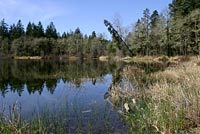 |
||
| |
This is a 6 second recording of the encounter call of a male toad when approached by another toad, probably a male. |
|
| This is a 4 second recording of the encounter of two toads, probably two males. | ||
| This is a 4 second recording of the encounter of two toads, probably two males. | ||
| |
This is a 10 second recording of the encounter of two toads, probably two males. | |
| Waveform and Sonogram | ||
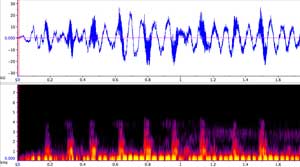 |
||
The image above is a visual representation of this call. Click on it to see a larger image. Click here for information about how to read the waveform and sonogram images. |
||
| Short Video | ||
| A Boreal Toad gives a release call after he is picked up and gently grasped across the back. (It is unharmed.) This is a warning call, the same one he makes when another male toad comes into his territory or climbs onto his back and grabs him tightly with his legs. |
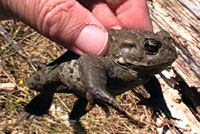 |
|
You can listen to more recordings of Boreal Toads on this cd: Carlos Davidson - Frog and Toad Calls of the Pacific Coast 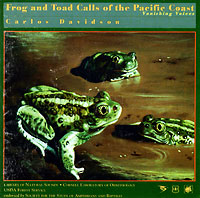 and on the cd that comes with this book: Lang Elliott, Carl Gerhardt, and Carlos Davidson - The Frogs and Toads of North America - Houghton Mifflin Harcourt.  |
||
Return to the Top
© 2000 -
